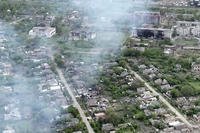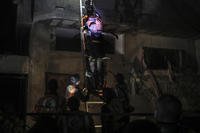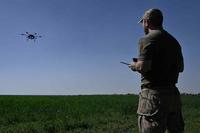Say what you want about Navy Expeditionary Combat Command -- and many people have -- it's a part of the service that tends to try to take a realistic view of how it might be used in a future conflict. Look, it says: We're not Marines, and we're not going to have that many guys, but in an invasion-style scenario, we may be tasked with patrolling or controlling large sections of coastline, including inland waterway systems. Let's say the Marines get the grid squares on the map for the assault beach and their objectives ashore, but somebody needs to look after the ones next door, just in case, and to patrol the coastline and local waterways. So how do we use the sailors we have to the greatest effect? This is the military, so the answer, of course, is technology.
It began with NECC's "Naval Expeditionary Overwatch" concept, which linked small UAVs, manned or unmanned patrol boats, and an up-gunned, up-tech'ed Humvee. All those toys, networked and run from a forward control base, would let only about 10 sailors monitor an area of up to 10 or even 20 square miles. If the Scan Eagle spotted some bad guys conducting villain operations, commanders could send the roving Humvee to intercept and attack them; if the unmanned boat spotted an enemy craft, it could deafen the bad guys with its onboard Long Range Acoustic Device or open fire with its own onboard gun. If worst came to worse and a major enemy force entered the sector all these toys were monitoring, sailors wouldn't try to fight it out. They'd just pull back and report, then call in the Marines or support from the fleet offshore.
Now NECC has another system-of-systems concept to help a small number of sailors keep a coordinated picture of a relatively large area. The Deployable Joint Command and Control system joins "intelligence, surveillance technology, coalition networking, secret networking, video, and telecommunications into one integrated system," the Navy says. Here's how this week's official story broke it down:
"The system brings in every element of existing communications," said Senior Chief Information Systems Technician David Pabon, Leading Chief Petty Officer at Riverine Squadron (RIVRON) 1. "DJC2 gets you pretty much everything you need, one way or the other. You have to configure the system a little bit, and there is specific equipment to bring, but everything you need is available."The system takes battle space input from sensors and forward units, then communicates it miles away to provide real-time visual representation of dynamic battle space, Pabon explained. The capability to provide bandwidth from the battle space to expeditionary planners allows decision makers to concentrate on what expeditionary sailors need to help commanders control the inland waterways and rivers harbors and shorelines ...
The DJC2 demonstration provided the adaptive telecommunications solution today's expeditionary forces require. "The key DJC2 parameters are transportability, scalability, and flexibility," said Chase. "We can go from an advance force of two people, on a commercial aircraft, setting up two networks in 30 minutes, up to 240 people on five networks set up inside of 24 hours. We run the complete range from very small unit to complete joint task force headquarters. Somewhere in the middle is what NECC needs, and that's what we're experimenting here at TW11."
Yes, it does sound a lot like Future Combat Systems -- you can almost close your eyes and picture the PowerPoint slide showing the notional battlespace with all the vehicles and sensors "talking" via little lightning bolts -- but let's leave that aside for now. Assuming NECC can get its new comms suite to work as envisioned, the real question is, when would it use it? Pure communications gear might come in handy more often than the Naval Expeditionary Overwatch equipment, but still, as our colleague Christian Lowe has written, the crystal ball is very cloudy for NECC's riverine units. Maybe, if engineers can adapt it for use in humanitarian and disaster response scenarios as well as in wars, it might come in handy after all.








